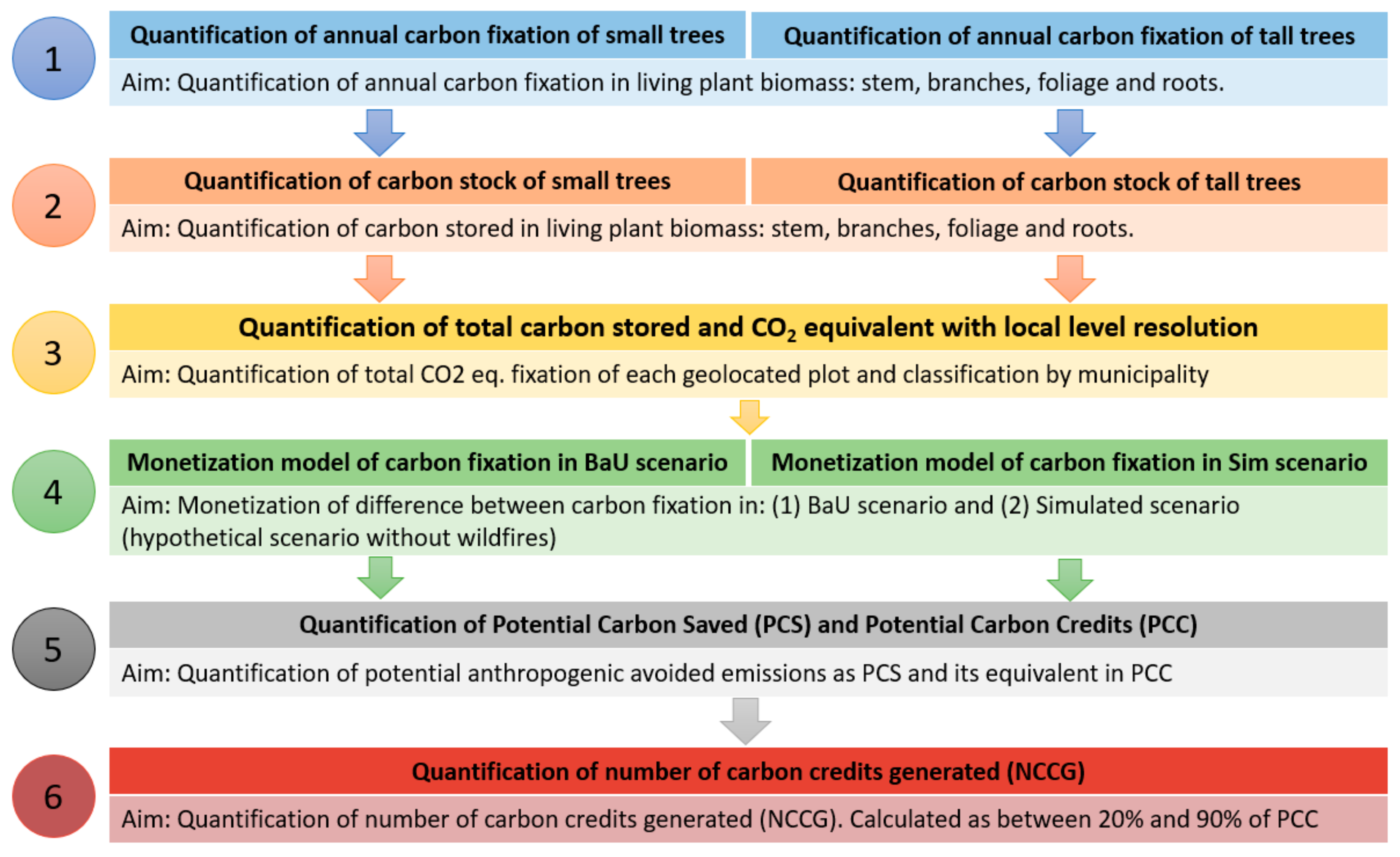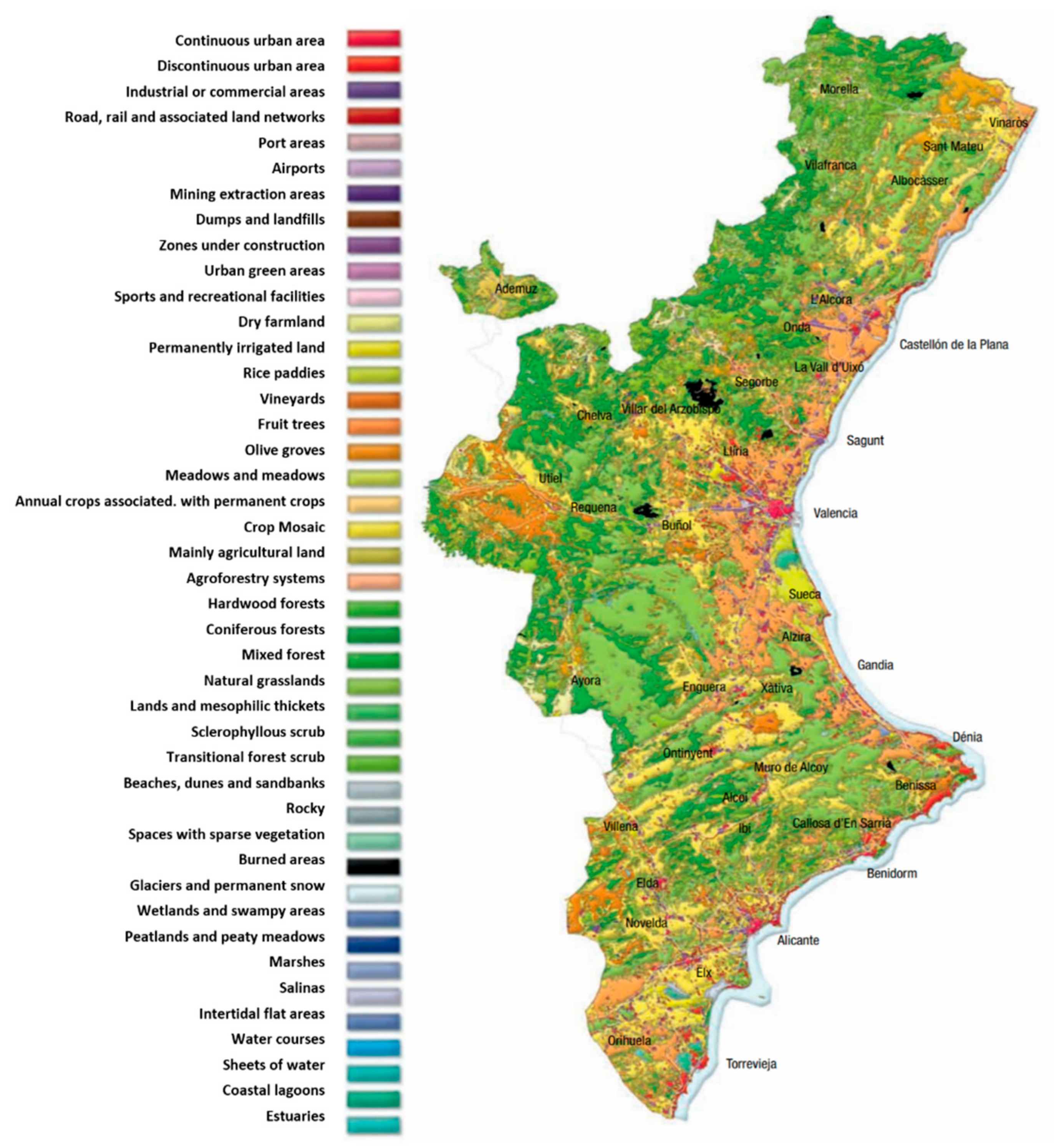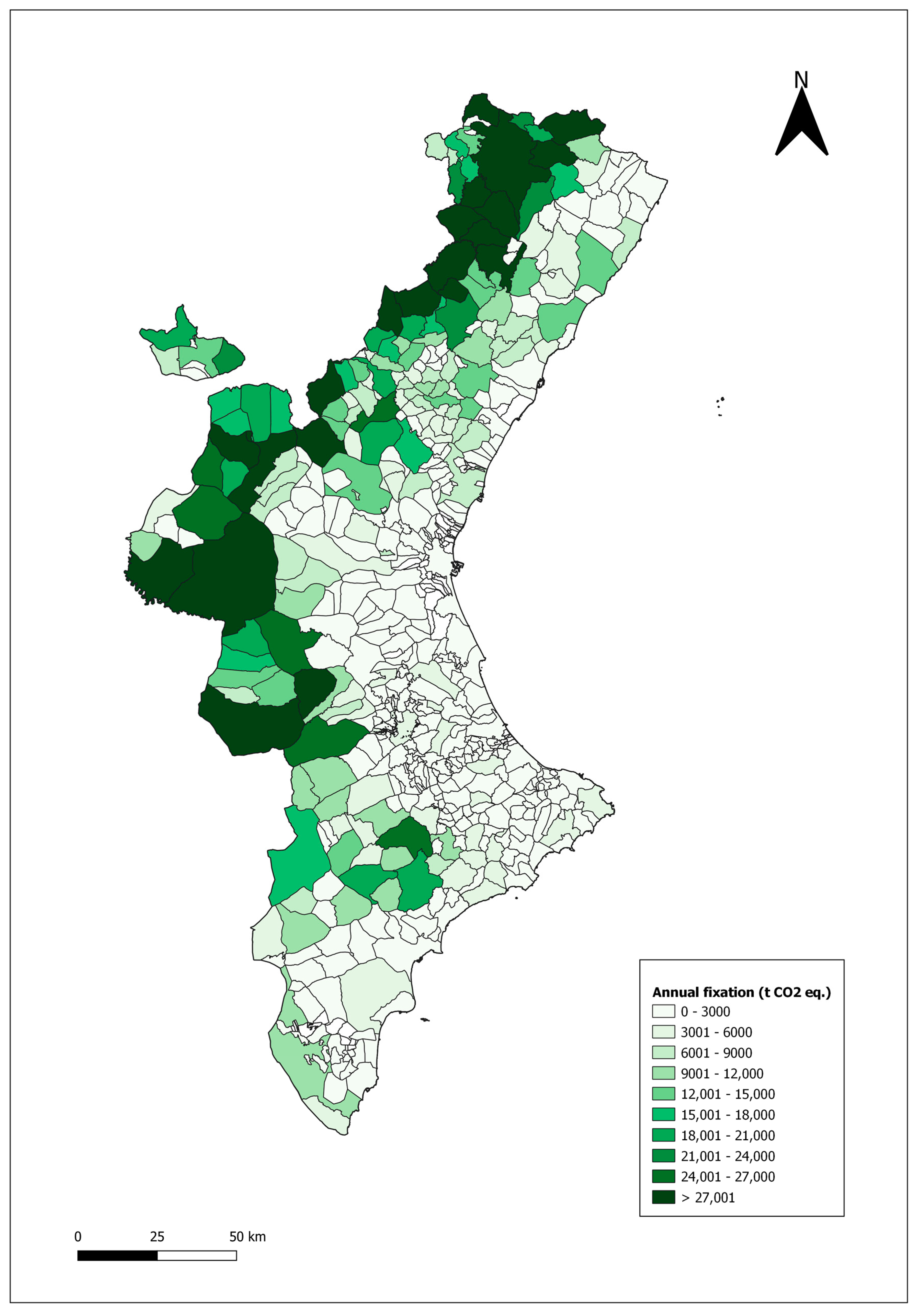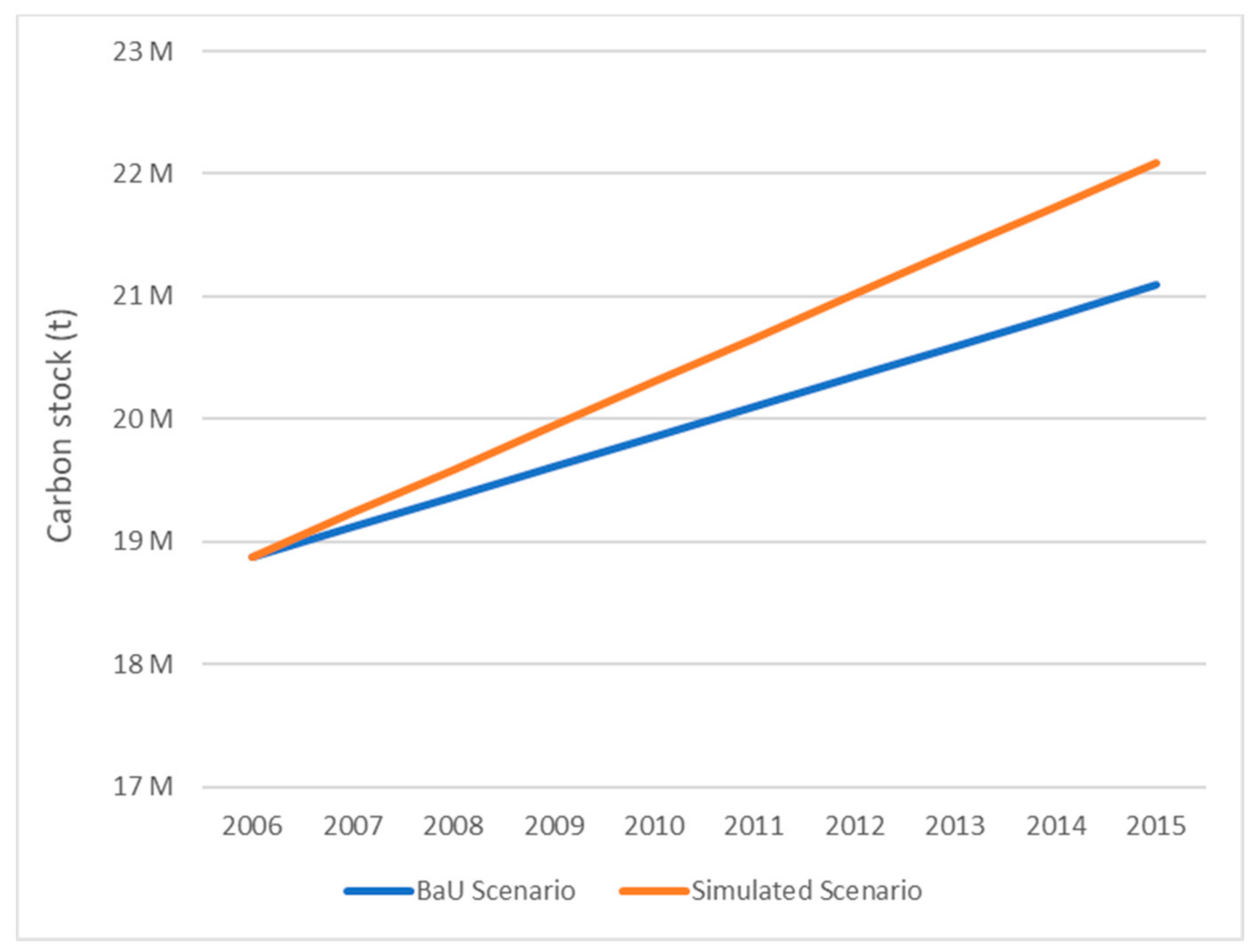Potential Analysis of Mediterranean Forestry for Offsetting GHG Emissions at Regional Level: Evidence from Valencia, Spain
Abstract
:1. Introduction
- (a)
- afforestation, reforestation or forest management to increase the carbon fixed by forests;
- (b)
- (c)
- preservation of existing forests to avoid or reduce emissions due to anthropogenic disturbances (deforestation) or natural disturbances (pests, hurricanes, snowfalls or wildfires) through preventive and sustainable forest management.
- (a)
- number of years with increased fire risks;
- (b)
- season length with severe meteorological conditions that increase fire risks; and
- (c)
- extreme events (e.g., total number of days with Fire Weather Index (FWI) >45 and especially episodes with FWI >45 for seven consecutive days) during summer or drought seasons are increasing.
- (a)
- regulatory compliance market: used by companies and governments that by law have to account for their GHG emissions and is regulated by mandatory national, regional or international carbon reduction regimes.
- (b)
- voluntary market: carbon credits trade is on voluntarily basis.
- 1.
- to quantify CO2 fixation in the total biomass of forests in the study area under Mediterranean conditions;
- 2.
- to develop and to apply a methodology to monetize the CO2 eq. fixation of forests under Mediterranean conditions;
- 3.
- to compare total forest CO2 fixation with total GHG emissions at the regional level in the case study region; and
- 4.
- to evaluate the potential of Mediterranean forestry for offsetting GHG emissions.
2. Materials and Methods
2.1. Regional Case Study
2.2. Quantification of Carbon Fixation in Forest Biomass under Mediterranean Conditions
2.2.1. Quantification of Carbon Fixation of Small Trees
2.2.2. Quantification of Carbon Fixation of Tall Trees
2.3. Quantification of Total Carbon Fixed and CO2 Equivalent with Local Level Resolution
2.4. Monetization of Carbon Fixation in Mediterranean Forests
2.4.1. Model for Monetization of Carbon Fixation in a Business as Usual (BaU) Scenario
2.4.2. Model for Monetization of Carbon Fixation in a Simulated Scenario
2.5. Comparison between Carbon Fixation with Total GHG Emissions
2.6. Evaluation of the Potential of Mediterranean Forestry for Offsetting GHG Emissions
3. Results and Discussion
3.1. Total Carbon Fixation by Forest Biomass
3.2. Value of Carbon Fixed by Mediterranean Forests
3.3. Carbon Fixation in Relation to Total GHG Emissions
3.4. Potential of Mediterranean Forestry for Offsetting GHG Emissions
4. Conclusions
Author Contributions
Funding
Institutional Review Board Statement
Informed Consent Statement
Acknowledgments
Conflicts of Interest
References
- Intergovernmental Panel on Climate Change (IPCC). Summary for Policymakers Climate Change 2001: Mitigation. A Report of Working Group III of the Intergovernmental Panel on Climate Change. Available online: https://www.ipcc.ch/site/assets/uploads/2018/07/wg2TARsummaries.pdf (accessed on 7 April 2021).
- Intergovernmental Panel on Climate Change (IPCC) Guidelines for National Greenhouse Gas Inventories. Task Force on National Greenhouse Gas Inventories (TFI), 2006. Available online: https://www.ipcc-nggip.iges.or.jp/public/2006gl/ (accessed on 7 April 2021).
- Vine, E.; Sathaye, J.; Makundi, W. Guidelines for the Monitoring, Evaluation, Reporting, Verification and Certification of Forestry Projects for Climate Change Mitigation, LBNL-41543, Ernest Orlando Lawrence Berkeley National Laboratory; Environmental Energy Technologies Division: Berkeley, CA, USA, 1999; p. 146. [Google Scholar]
- IEA Bioenergy. Greenhouse Gas Balances of Biomass: Answers to Ten Frequently Asked Questions about Bioenergy, Carbon Sinks and Their Role in Global Climate Change. 2001. Available online: https://www.ieabioenergy.com/wp-content/uploads/2013/10/13_task38faq.pdf (accessed on 7 April 2021).
- Prato, T. Conceptual Framework for Assessing the Sustainability of Forest Fuel Reduction Treatments and Their Adaptation to Climate Change. Sustainability 2015, 7, 3571–3591. [Google Scholar] [CrossRef] [Green Version]
- Wang, L.; Cui, Z.; Kuuluvainen, J.; Sun, Y. Does Forest Industries in China become Cleaner? A Prospective of Embodied Carbon Emission. Emission. Sustainability 2021, 13, 2306. [Google Scholar] [CrossRef]
- Marques, S.; Marto, M.; Bushenkov, V.; McDill, M.; Borges, J.G. AddressingWildfire Risk in Forest Management Planning with Multiple Criteria Decision Making Methods. Sustainability 2017, 9, 298. [Google Scholar] [CrossRef] [Green Version]
- Canadell, J.G.; Raupach, M.R. Managing forests for climate change mitigation. Science 2008, 320, 1456–1457. [Google Scholar] [CrossRef] [PubMed] [Green Version]
- Streck, C.; Scholz, S.M. The role of forests in global climate change: Whence we come and where we go. Int. Aff. 2006, 82, 861–879. [Google Scholar] [CrossRef]
- Binkley, C.S.; Brand, D.; Harkin, Z.; Bull, G.; Ravindranath, N.H.; Obersteiner, M.; Nilsson, S.; Yamagata, Y.; Krott, M. Carbon sink by the forest sector—options and needs for implementation. For. Policy Econ. 2002, 4, 65–77. [Google Scholar] [CrossRef]
- Vigna, I.; Besana, A.; Comino, E.; Pezzoli, A. Application of the Socio-Ecological System Framework to Forest Fire Risk Management: A Systematic Literature Review. Sustainability 2021, 13, 2121. [Google Scholar] [CrossRef]
- Moriondo, M.; Good, P.; Durão, R.; Bindi, M.; Giannakopoulos, C.; Corte-Real, J. Potential impact of climate change on fire risk in the Mediterranean area. Clim. Res. 2006, 31, 85–95. [Google Scholar] [CrossRef]
- Joint Research Centre (JRC). Forest fires in Europe 2009, Joint Research Centre Scientific and Technical Reports; Report No. 10; Publication office of the European Union: Luxemburg, 2009. [Google Scholar]
- Marchi, M.; Chianucci, F.; Ferrara, C.; Pontuale, G.; Pontuale, E.; Mavrakis, A.; Morrow, N.; Rossi, F.; Salvati, L. Sustainable Land-Use, Wildfires, and Evolving Local Contexts in a Mediterranean Country, 2000–2015. Sustainability 2018, 10, 3911. [Google Scholar] [CrossRef] [Green Version]
- Peters-Stanley, M.; Hamilton, K.; Yin, D. Leveraging the Landscape: State of the Forest Carbon Markets 2012. Ecosystem Marketplace. 2012. Available online: https://www.forest-trends.org/wp-content/uploads/imported/sofcm-final_11-7-12-pdf.pdf (accessed on 7 April 2021).
- Kollmuss, A.; Zink, H.; Polycarp, C. Making Sense of the Voluntary Carbon Market: A Comparison of Carbon Offset Standards. Wwf Ger. 2008. Available online: https://mediamanager.sei.org/documents/Publications/SEI-Report-WWF-ComparisonCarbonOffset-08.pdf (accessed on 7 April 2021).
- Ulucak, R.; Yücel, A.G.; Koçak, E. The Process of Sustainability: From Past to Present. In Environmental Kuznets Curve (EKC); Elsevier: Amsterdam, The Netherlands, 2019; Chapter 5; pp. 37–53. ISBN 9780128167977. [Google Scholar] [CrossRef]
- FAO. Natural Resources Management and Environment Department Food and Agriculture Organization of the United Nations (FAO). Carbon Finance Possibilities for Agriculture, Forestry and Other Land Use Projects in a Smallholder Context. Rome. 2010. Available online: http://www.fao.org/3/i1632e/i1632e.pdf (accessed on 7 April 2021).
- European Commission. EU ETS Handbook. European Union, Emission Trading System Handbook. 2015. Available online: https://ec.europa.eu/clima/sites/clima/files/docs/ets_handbook_en.pdf (accessed on 7 April 2021).
- Hamilton, K.; Bayon, R.; Turner, G.; Higgins, D. State of the Voluntary Carbon Markets 2007: Picking Up Steam. EcoSystem Marketplace and New Carbon Finance. Available online: http://ecosystemmarketplace.com/documents/acrobat/StateoftheVoluntaryCarbonMarket17July.pdf (accessed on 7 April 2021).
- Oficina Española Cambio Climático (OECC). Información Sobre la Sección de Proyectos de Absorción de Dióxido de Carbono. Registro de Huella de Carbono, Compensación y Proyectos de Absorción de Dióxido de Carbono; Oficina Española Cambio Climático: Madrid, Spain, 2019. [Google Scholar]
- McKenzie, D.; Gedalof, Z.; Peterson, D.L.; Mote, P. Climatic change, wildfire, and conservation. Conserv. Biol. 2004, 18, 890–902. [Google Scholar] [CrossRef]
- Stephens, S.L. Forest fire causes and extent on United States Forest Service lands. Int. J. Wildland Fire 2005, 14, 213–222. [Google Scholar] [CrossRef]
- Westerling, A.L.; Hidalgo, H.G.; Cayan, D.R.; Swetnam, T.W. Warming and earlier spring increase western U.S. forest wildfire activity. Science 2006, 313, 940–943. [Google Scholar] [CrossRef] [Green Version]
- Miller, J.D.; Safford, H.D.; Crimmins, M.; Thode, A.E. Quantitative evidence for increasing forest fire severity in the Sierra Nevada and southern Cascade Mountains, California and Nevada, USA. Ecosystems 2009, 12, 16–32. [Google Scholar] [CrossRef]
- Köhl, M.; Neupane, P.R.; Mundhenk, P. REDD+ measurement, reporting and verification—A cost trap? Implications for financing REDD+MRV costs by result-based payments. Ecol. Econ. 2020, 168. [Google Scholar] [CrossRef]
- Maroto, C.; Segura, M.; Ginestar, C.; Uriol, J.; Segura, B. Sustainable Forest Management in a Mediterranean region: Social preferences. For. Syst. 2013, 22, 546–558. [Google Scholar] [CrossRef] [Green Version]
- PATFOR. Forestry Territorial Action Plan of the Valencian Community 2012. Generalitat Valenciana. Available online: http://agroambient.gva.es/auto/montes-bosques/PATFOR/01_MEMORIA/PATFOR_Memoria_version_final.pdf (accessed on 7 April 2021).
- Delgado-Artes, R. Análisis de los Patrones de Evolución de las Coberturas Forestales en la Provincia de Castellón en los Últimos 50 Años. Ph.D. Thesis, Universitat Politècnica de València, Valencia, Spain, 2015. [Google Scholar] [CrossRef]
- Giannakopoulos, C.; Bindi, M.; Moriondo, M.; LeSager, P.; Tin, T. Climate change impacts in the Mediterranean resulting from a 2°C global temperature rise. Rep. WWF 2005, 68, 209–224. [Google Scholar]
- European Environment Agency (EEA). Corine Land Cover. 2018. Available online: https://land.copernicus.eu/pan-european/corine-land-cover/clc2018 (accessed on 29 May 2020).
- Montero, G.; Ruiz-Peinado, R.; Muñoz, M. Producción de Biomasa y Fijación de CO2 por los Bosques Españoles; Instituto Nacional de Investigación y Tecnología Agraria y Alimentaria, Ministerio de Educación y Ciencia: Madrid, Spain, 2005. [Google Scholar]
- Lerma-Arce, V. Planificación, Logística y Valorización de Biomasa Forestal Residual en la Provincia de Valencia. Ph.D. Thesis, Universitat Politècnica de València, Valencia, Spain, 2015; p. 230. [Google Scholar]
- McGroddy, M.E.; Daufresne, T.; Hedin, L.O. Scaling of C:N:P stoichiometry in forests worldwide: Implications of terrestrial Redfield-type ratios. Ecology 2004, 85, 2390–2401. [Google Scholar] [CrossRef]
- Hughes, R.F.; Kauffman, J.B.; Jaramillo-Luque, V.J. Ecosystem-scale impacts of deforestation and land use in a humid tropical region of México. Ecol. Appl. 2000, 10, 515–527. [Google Scholar] [CrossRef]
- Feldpausch, T.R.; Rondon, M.A.; Fernandes, E.C.M.; Riha, S.J. Carbon and nutrient accumulation in secondary forests regenerating on pastures in central Amazonia. Ecol. Appl. 2004, 14, S164–S176. [Google Scholar] [CrossRef] [Green Version]
- Andreae, M.O.; Merlet, P. Emission of trace gases and aerosols from biomass burning. Glob. Biogeochem. Cycles 2001, 15, 955–966. [Google Scholar] [CrossRef] [Green Version]
- Gayoso, J.; Guerra, J.; Alarcón, D. Contenido de Carbono y Funciones de Biomasa en Especies Natives y Exóticas; Universidad Austral de Chile: Valdivia, Chile, 2002. [Google Scholar]
- Lamlom, S.H.; Savidge, R.A. A reassessment of carbon content in wood: Variation within and between 41 North American species. Biomass Bioenergy 2003, 25, 381–388. [Google Scholar] [CrossRef]
- Tragsa, Empresa de Transformación Agraria. Tercer Inventario Forestal Nacional (IFN 3). 2006. Available online: https://www.miteco.gob.es/es/biodiversidad/servicios/banco-datos-naturaleza/informacion-disponible/ifn3_base_datos_26_50.aspx (accessed on 3 April 2020).
- Life Forest CO2. 2019. Available online: http://lifeforestco2.eu/life-forest-co2-project/?lang=en (accessed on 13 April 2020).
- Woodland Carbon Code (WCC). United Kingdom. Published 9 July 2018. Available online: https://www.gov.uk/guidance/the-woodland-carbon-code-scheme-for-buyers-and-landowners (accessed on 13 April 2020).
- Registro Huella de Carbono (RHC). Available online: https://www.miteco.gob.es/es/cambio-climatico/temas/mitigacion-politicas-y-medidas/que_es_Registro.aspx (accessed on 13 April 2020).
- Carbomark. Development of Policies for the Creation of local Voluntary Carbon Markets for Mitigating Climate Change. Project LIFE07 ENV/IT/000388. 2011. Available online: https://ec.europa.eu/environment/life/project/Projects/index.cfm?fuseaction=home.showFile&rep=file&fil=CARBOMARK_Manual_EN.pdf (accessed on 1 June 2020).
- Croitoru, L. How much are Mediterranean forests worth? For. Policy Econ. 2007, 9, 536–545. [Google Scholar] [CrossRef]
- Plana, E.; Font, M.; Serra, M.; Borràs, M.; Vilalta, O. Fire and Wildfires in the Mediterranean; a Relationship Story between Forest and Society. Five Myths and Realities. Available online: http://efirecom.ctfc.cat/docs/revistaefirecom_en.pdf (accessed on 7 April 2021).
- Moreno, M.V.; Conedera, M.; Chuvieco, E.; Pezzatti, G.B. Fire regime changes and major driving forces in Spain from 1968 to 2010. Environ. Sci. Policy 2014, 37, 11–22. [Google Scholar] [CrossRef]
- Corona, P.; Ascoli, D.; Barbati, A.; Bovio, G.; Colangelo, G.; Elia, M.; Garfì, V.; Iovino, F.; Lafortezza, R.; Leone, V.; et al. Integrated forest management to prevent wildfires under Mediterranean environments. Ann. Silvic. Res. 2015, 39, 24–45. [Google Scholar] [CrossRef]
- Cabanes-Sanchez, M.; del Valle, E. El Carbono en los Ecosistemas Forestales Valencianos. 2016. Available online: http://www.plataformaforestalvalenciana.com/wp-content/uploads/2015/11/3%C2%AAcircular.pdf (accessed on 1 June 2020).
- MITECO. Los incendios Forestales en España. Decenio 2006–2015. Ministerio para la Transición Ecológica y el Reto Demográfico, 2020. Madrid, Spain. Available online: https://www.mapa.gob.es/es/desarrollo-rural/estadisticas/incendios-decenio-2006-2015_tcm30-511095.pdf (accessed on 7 April 2021).
- REMAS Project. Greenhouse Gas Emissions Risk Management in Wildfires. 2019–2022. Available online: http://www.isa.ulisboa.pt/ceabn/projecto/2/101/remas-managing-the-risk-of-emissions-of-gases-with-greenhouse-effect-from-wildfires (accessed on 7 April 2021).
- Hurteau, M.D.; Koch, G.W.; Hungate, B.A. Carbon protection and fire risk reduction: Toward a full accounting of forest carbon offsets. Front. Ecol. Environ. 2008, 6, 493–498. [Google Scholar] [CrossRef] [Green Version]
- European Commission. Directive 2003/87/EC of the European Parliament and of the Council of 13 October 2003 Establishing a Scheme for Greenhouse Gas Emission Allowance Trading within the Community and Amending Council Directive 96/61/EC. Available online: https://eur-lex.europa.eu/legal-content/EN/TXT/?uri=celex%3A32003L0087 (accessed on 7 April 2021).
- Oficina Española de Cambio Climático (OECC). Instalaciones Afectadas por la ley 1/2005 Informe de Aplicación del año 2018. Available online: https://www.miteco.gob.es/es/cambio-climatico/temas/comercio-de-derechos-de-emision/ley1_2005-informeaplicacion2018_tcm30-497632.pdf (accessed on 5 May 2020).
- Ecological Transition and Demographic Challenge Ministry. National Inventory of Emissions to the Atmosphere. GHG Emissions 1990–2018. March 2020. Available online: https://www.miteco.gob.es/es/calidad-y-evaluacion-ambiental/temas/sistema-espanol-de-inventario-sei-/es-2020-nir_tcm30-508122.pdf (accessed on 7 April 2021).
- Tong, X.; Brandt, M.; Yue, Y.; Ciais, P.; Rudbeck Jepsen, M.; Penuelas, J.; Wigneron, J.P.; Xiao, X.; Song, X.P.; Horion, S.; et al. Forest management in southern China generates short term extensive carbon sequestration. Nat. Commun. 2020, 11, 129. [Google Scholar] [CrossRef]
- Van Khuc, Q.; Le, T.-A.T.; Nguyen, T.H.; Nong, D.; Tran, B.Q.; Meyfroidt, P.; Tran, T.; Duong, P.B.; Nguyen, T.T.; Tran, T.; et al. Forest Cover Change, Households’ Livelihoods, Trade-Offs, and Constraints Associated with Plantation Forests in Poor Upland-Rural Landscapes: Evidence from North Central Vietnam. Forests 2020, 11, 548. [Google Scholar] [CrossRef]
- Lin, D.; Lin, Y. Stakeholders of Voluntary Forest Carbon Offset Projects in China: An Empirical Analysis. Adv. Meteorol. 2015, 7. [Google Scholar] [CrossRef]




| Stand | Dominant Species | Occupation (%) | Stage | Canopy Cover (%) |
|---|---|---|---|---|
| 01 | Pinus halepensis | ≥70 | Old growth | 70–100 |
| 02 | Pinus halepensis | ≥70 | Old growth | 40–69 |
| 03 | Pinus halepensis | ≥70 | Old growth | 20–39 |
| 04 | Pinus halepensis | ≥70 | Young forest | 5–100 |
| 05 | Pinus nigra and P. pinaster or mixed with Pinus halepensis | ≥70; 30 ≤ Sp. < 70 | Old growth | 40–100 |
| 06 | Pinus nigra and P. pinaster or mixed with Pinus halepensis | ≥70; 30 ≤ Sp. < 70 | Old growth | 20–39 |
| 07 | Quercus ilex or mixed with Pinus halepensis or Ceratonia siliqua | ≥70; 30 ≤ Sp. < 70 | Old growth | 20–100 |
| 08 | Quercus ilex or mixed with Pinus spp. | ≥70; 30 ≤ Sp. < 70 | Young forest | 5–100 |
| 09 | Juniperus thurifera | ≥70 | Old growth, Young Forest | 20–100 5–100 |
| 10 | Riverside trees (Populus spp., Fraxinus spp.…) | ≥70; 30 ≤ Sp. < 70 | All | 5–100 |
| 11 | Scrub | ≥70; 30 ≤ Sp. < 70 | Old growth | 5–19 |
| Species or Group of Species | rt: Number of Tall Trees Per Hectare (tt/ha) | VWB (m3) | AIVCrt (m3) | st: Number of Small Trees Per Hectare (st/ha) |
|---|---|---|---|---|
| Pinus halepensis | 605.55 | 67.962 | 2.349 | 286.48 |
| Pinus pinaster | 1.39 | 0.305 | 0.010 | 3.82 |
| Pinus nigra | 0.07 | 0.015 | 0.000 | 0.00 |
| Quercus ilex | 3.17 | 0.108 | 0.002 | 38.20 |
| Juniperus thurifera | 1.27 | 0.021 | 0.001 | 138.78 |
| Ceratonia siliqua | 2.80 | 0.212 | 0.002 | 5.09 |
| Riverside trees (Populus spp., Fraxinus spp.…) | 0.03 | 0.071 | 0.001 | 4.46 |
| Other hardwood trees | 2.23 | 0.075 | 0.001 | 12.73 |
| Total | 616.51 | 68.773 | 2.366 | 489.56 |
| Aerial Biomass | Radical Biomass | ||||||
|---|---|---|---|---|---|---|---|
| Species | Stem | Branches | Leaves | Total | |||
| R > 7 cm | R 2–7 cm | R < 2 cm | |||||
| Pinus halepensis | 37% | 9.80% | 8.40% | 21.20% | 0% | 76.40% | 23.60% |
| Pinus nigra | 51.10% | 5.40% | 8.00% | 15.90% | 0% | 80.40% | 19.60% |
| Pinus pinaster | 61.9% | 0.9% | 4.1% | 10.9% | 0.0% | 77.9% | 22.1% |
| Pinus pinea | 36.4% | 17.7% | 11.4% | 13.4% | 5.6% | 84.5% | 15.5% |
| Pinus sylvestris | 56.1% | 2.5% | 7.0% | 7.4% | 5.6% | 78.6% | 21.4% |
| Populus x euramericana | 48.9% | 6.4% | 6.4% | 6.1% | 2.3% | 76.0% | 24.0% |
| Quercus ilex | 18.4% | 24.2% | 12.2% | 8.7% | 2.0% | 65.4% | 34.6% |
| Quercus faginea | 25.1% | 24.7% | 9.9% | 5.5% | 3.2% | 68.4% | 31.6% |
| Quercus suber | 32.4% | 30.8% | 10.5% | 2.4% | 1.4% | 77.5% | 22.5% |
| Juniperus thurifera | 35.8% | 7.8% | 14.6% | 9.3% | 8.5% | 76.1% | 23.9% |
| Juniperus oxycedrus | - | - | - | - | - | 21.8% | 78.2% |
| Ceratonia siliqua | 17.7% | 13.1% | 7.4% | 7.7% | 5.3% | 51.2% | 48.8% |
| Olea europaea | 19.6% | 25.0% | 13.3% | 9.3% | 1.3% | 68.6% | 31.4% |
| Fraxinus excelsior | 24.4% | 11.7% | 11.8% | 9.9% | 0.0% | 57.8% | 42.2% |
| Variable | Value | Reference |
|---|---|---|
| Average of carbon stock extracted from forest to products manufacturing | 417,273 t C/year | [49] |
| Average of carbon stock extracted from forest to bioenergy | 71,300 t C/year | [49] |
| Forestry area of total region in hectares | 1,200,194 ha | [40] |
| Average of burned area of the 10 years in hectares | 9732 ha/year | [50] |
| Average of biomass consumed during wildfire due to severity | 72.6% | Calculated in REMAS Interreg SUDOE project currently in progress [51] |
| Municipality Name | Annual CO2 eq. Fixation (t CO2 eq./Year) | Relative Value Regarding Total CO2 eq. Fixation (%) | Cumulative Relative Value of CO2 eq. (%) |
|---|---|---|---|
| Morella | 269,910 | 8.53 | 8.53 |
| Requena | 111,459 | 3.52 | 12.06 |
| Pobla de Benifassà | 93,688 | 2.96 | 15.02 |
| Vistabella del Maestrat | 93,421 | 2.95 | 17.97 |
| Vallibona | 78,851 | 2.49 | 20.47 |
| El Toro | 72,732 | 2.30 | 22.77 |
| Ares del Maestrat | 66,485 | 2.10 | 24.87 |
| Ayora | 60,373 | 1.91 | 26.78 |
| Villahermosa del Río | 56,822 | 1.80 | 28.57 |
| Vilafranca | 44,387 | 1.40 | 29.98 |
| Venta del Moro | 43,399 | 1.37 | 31.35 |
| Castellfort | 40,518 | 1.28 | 32.63 |
| Cortes de Arenoso | 40,414 | 1.28 | 33.91 |
| Zorita del Maestrazgo | 37,056 | 1.17 | 35.08 |
| Chelva | 36,819 | 1.16 | 36.24 |
| Culla | 36,259 | 1.15 | 37.39 |
| Benassal | 30,870 | 0.98 | 38.37 |
| Andilla | 30,498 | 0.96 | 39.33 |
| Tuéjar | 28,774 | 0.91 | 40.24 |
| BaU Scenario | Simulated Scenario | ||||
|---|---|---|---|---|---|
| 2006 | Ct0 (t C) | 18,877,336 | 2006 | Ct0 (t C) | 18,877,336 |
| 2007 | Ctm (t C) | 19,123,160 | 2007 | CSimtm (t C) | 19,234,277 |
| 2008 | 19,368,985 | 2008 | 19,591,219 | ||
| 2009 | 19,614,810 | 2009 | 19,948,161 | ||
| 2010 | 19,860,634 | 2010 | 20,305,103 | ||
| 2011 | 20,106,459 | 2011 | 20,662,045 | ||
| 2012 | 20,352,284 | 2012 | 21,018,986 | ||
| 2013 | 20,598,108 | 2013 | 21,375,928 | ||
| 2014 | 20,843,933 | 2014 | 21,732,870 | ||
| 2015 | 21,089,758 | 2015 | 22,089,812 | ||
Publisher’s Note: MDPI stays neutral with regard to jurisdictional claims in published maps and institutional affiliations. |
© 2021 by the authors. Licensee MDPI, Basel, Switzerland. This article is an open access article distributed under the terms and conditions of the Creative Commons Attribution (CC BY) license (https://creativecommons.org/licenses/by/4.0/).
Share and Cite
Lorenzo-Sáez, E.; Oliver-Villanueva, J.-V.; Lerma-Arce, V.; Yagüe-Hurtado, C.; Lemus-Zúñiga, L.G. Potential Analysis of Mediterranean Forestry for Offsetting GHG Emissions at Regional Level: Evidence from Valencia, Spain. Sustainability 2021, 13, 4168. https://doi.org/10.3390/su13084168
Lorenzo-Sáez E, Oliver-Villanueva J-V, Lerma-Arce V, Yagüe-Hurtado C, Lemus-Zúñiga LG. Potential Analysis of Mediterranean Forestry for Offsetting GHG Emissions at Regional Level: Evidence from Valencia, Spain. Sustainability. 2021; 13(8):4168. https://doi.org/10.3390/su13084168
Chicago/Turabian StyleLorenzo-Sáez, Edgar, Jose-Vicente Oliver-Villanueva, Victoria Lerma-Arce, Celia Yagüe-Hurtado, and Lenin Guillermo Lemus-Zúñiga. 2021. "Potential Analysis of Mediterranean Forestry for Offsetting GHG Emissions at Regional Level: Evidence from Valencia, Spain" Sustainability 13, no. 8: 4168. https://doi.org/10.3390/su13084168






